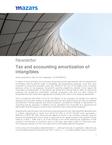
Tax and accounting amortization of intangibles
In relation to the first thesis, the controversy arose because the administration did not recognize the amortization that the plaintiff made of intangibles and preoperating expenses, since they were amortized for accounting purposes under the method of the sum of the digits of the increasing balances, while, for tax purposes, the plaintiff used the straight-line method. In this regard, the Corporation considered that: "In accordance with Article 66 of Decree 2649 of 1993, for accounting purposes, the straight-line amortization methods, production units and any other method of recognized technical value that is appropriate according to the nature of the asset are admissible.
And in accordance with Article 143 of the Tax Statute, for tax purposes, the straight line, balance reduction and any other method of recognized technical value authorized by the Dian are allowed" and therefore "nothing opposes that income taxpayers use different methods of depreciation for accounting and tax purposes. In addition, the tax regulations do not provide as a requirement for depreciation that the taxpayer uses the same method for accounting and tax purposes".
Regarding the second thesis, the controversy arose because the Dian "decreased the declared value of inflation adjustments to equity from $2.547.371.000 to $1.977.181.000 which generated a difference of $570.190. 000, value that was added as income in the monetary correction account, because the adjustments to the increase in equity due to the capital increase of the plaintiff must be made as of May 1, 1999, that is, as of the first day of the month following the registration of said increase in the chamber of commerce, which, in this case, was made on April 21 of the same year. The foregoing, because it is from such date that it is enforceable against third parties".
In this sense, the Corporation established that "(...) although the lack of registration makes the act not enforceable against third parties (art. 901 C. de Co.), (...), the Administration does not have the character of "third party", since the tax return is not properly the fact or act generating the obligation, since it is the accusation of the tax due to the occurrence of the events provided in the law as generators of this. That is to say, whatever the circumstance that gives rise to the tax relationship, the Administration always acquires and retains the condition of main subject of the legal tax relationship".
Thus, contrary to the inconsistency of the Dian's positions on these issues, the position of the Council of State has remained unchanged for the last 15 years.


